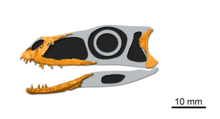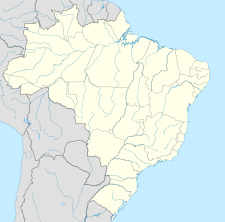| Maehary | |
|---|---|

| |
| Hypothetical skull reconstruction | |
|
Scientific classification
| |
| Domain: | Eukaryota |
| Kingdom: | Animalia |
| Phylum: | Chordata |
| Class: | Reptilia |
| Clade: | Archosauria |
| Clade: | Pseudosuchia |
| Clade: | Suchia |
| Family: | † Gracilisuchidae (?) |
| Genus: | †
Maehary Kellner et al., 2022 |
| Species: | †M. bonapartei
|
| Binomial name | |
| †Maehary bonapartei Kellner et al., 2022
| |
Maehary (meaning "one who looks to the sky" in Guaraní) is an extinct genus of probable gracilisuchid pseudosuchian archosaurs from the Late Triassic ( Norian) Caturrita Formation of Rio Grande do Sul, Brazil. The genus contains a single species, M. bonapartei, known from a partial skull and fragmentary postcrania. Maehary was originally described as the basalmost member of the Pterosauromorpha, but several subsequent studies have suggested pseudosuchian affinities are more likely. If this is correct, it would represent the youngest known member of the Gracilisuchidae.
Discovery and naming

The Maehary holotype specimen, CAPPA/ UFSM 0300, was discovered between 2002 and 2005 in layers of the Caturrita Formation (Linha São Luiz Site, Candelária Sequence, Santa Maria Supersequence) near Faxinal do Soturno, Rio Grande do Sul, Brazil. The holotype consists of a partial skull, vertebral centra, and a fragmentary scapula. Another specimen, UFRGS-PV-0769-T, was also assigned to the genus, consisting of a left maxilla. The maxilla was originally described in 2010 as belonging to the supposed basal pterosaur Faxinalipterus. [1] However, when Faxinalipterus was reinterpreted as a lagerpetid in 2022, the bone was removed from its hypodigm and reidentified as belonging to Maehary. [2]
In 2022, Kellner et al. described Maehary bonapartei as a new genus and species of pterosauromorph. The generic name, "Maehary" is derived from the Guarani-Kaiowa phrase "Ma'ehary", roughly translating to "who looks to the sky", in reference to the alleged pterosauromorph affinities of the taxon. The specific name, "bonapartei", honors the Argentine paleontologist José F. Bonaparte. [2]
Later analyses suggested that Maehary actually represents a gracilisuchid member of the clade Pseudosuchia, rather than a pterosauromorph. [3]
Classification
Kellner et al. (2022) recovered Maehary as the earliest diverging member of Pterosauromorpha. The results of their phylogenetic analysis are shown in the cladogram below, illustrating its position within the Archosauria: [2]
| Archosauria |
| |||||||||||||||||||||||||||||||||||||||||||||||||||
In the 2023 description of the lagerpetid Venetoraptor, Müller et al. corrected some of the phylogenetic characters that led to the recovery of Maehary as a pterosauromorph. The updated analysis recovered it as a derived member of the suchian clade Gracilisuchidae, as the sister taxon to Gracilisuchus. The authors did not discuss the updated phylogenetic position. [4] Later that year, Foffa et al. discussed the phylogenetic affinities of Maehary, explaining that it could not be confidently regarded as a pterosauromorph without additional fossil material to clarify its anatomy. While their maximum parsimony analyses found it to be the basalmost pterosauromorph (similar to Kellner et al. in 2022), using unconstrained Bayesian inference analyses moved it to a polytomy with Lewisuchus and Silesauridae as the sister taxon of the Dinosauria. As such, they cautioned that the position of Maehary should be regarded as uncertain. [5] A 2024 analysis focused on lagerpetids, a clade of early pterosauromorphs, also recovered Maehary as a gracilisuchid. [6] Later in 2024, Rodrigo T. Müller described the well-preserved remains of a new gracilisuchid, Parvosuchus aurelioi. When included in a phylogenetic dataset, it was found in the clade of Gracilisuchus + Maehary. Since the inclusion of an unequivocal gracilisuchid did not affect the relationships of Maehary, he suggested that this was the appropriate classification for the taxon. [3] The archosaurian results of Müller et al. (2023) are displayed in the cladogram below:
References
- ^ J. F. Bonaparte, C. L. Schultz, and M. B. Soares. (2010). Pterosauria from the Late Triassic of southern Brazil. In S. Bandyopadhyay (ed.), New Aspects of Mesozoic Biodiversity, Lecture Notes in Earth Sciences 132:63-71.
- ^ a b c Kellner, A.W.A.; Holgado, B.; Grillo, O.; Pretto, F.A.; Kerber, L.; Pinheiro, F.L.; Soares, M.B.; Schultz, C.L.; Lopes, R.T.; Araújo, A.; Müller, R.T. (2022). "Reassessment of Faxinalipterus minimus, a purported Triassic pterosaur from southern Brazil with the description of a new taxon". PeerJ. 10: e13276. doi: 10.7717/peerj.13276. PMC 9074864. PMID 35529502.
- ^ a b Müller, Rodrigo T. (2024-06-20). "A new small-sized predatory pseudosuchian archosaur from the Middle-Late Triassic of Southern Brazil". Scientific Reports. 14 (1): 12706. doi: 10.1038/s41598-024-63313-3. ISSN 2045-2322. PMC 11189902.
- ^ Müller, R. T.; Ezcurra, M. D.; Garcia, M. S.; Agnolín, F. L.; Stocker, M. R.; Novas, F. E.; Soares, M. B.; Kellner, A. W. A.; Nesbitt, S. J. (2023). "New reptile shows dinosaurs and pterosaurs evolved among diverse precursors". Nature. 620 (7974): 589–594. doi: 10.1038/s41586-023-06359-z.
- ^ Foffa, D.; Nesbitt, S. J.; Butler, R. J.; Brusatte, S. L.; Walsh, S.; Fraser, N. C.; Barrett, P. M. (2023). "The osteology of the Late Triassic reptile Scleromochlus taylori from μCT data". The Anatomical Record. 307 (4): 1113–1146. doi: 10.1002/ar.25335. hdl: 20.500.11820/2411a888-1efb-42d1-a498-fc031145ed86. PMID 37846180.
- ^ Garcia, M. S.; Fonseca, A. O.; Doering, M.; da Rosa, Á. A. S.; Müller, R. T. (2024). "A new sympatric occurrence of lagerpetids (Pan-Aves, Pterosauromorpha) in the Upper Triassic of southern Brazil". Journal of South American Earth Sciences. 140. 104897. Bibcode: 2024JSAES.14004897G. doi: 10.1016/j.jsames.2024.104897.

